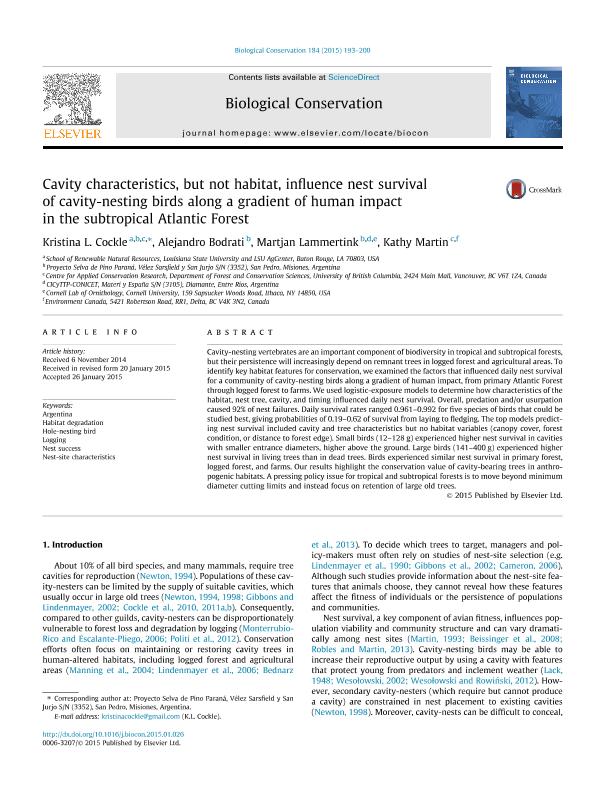Mostrar el registro sencillo del ítem
dc.contributor.author
Cockle, Kristina Louise

dc.contributor.author
Bodrati, Alejandro
dc.contributor.author
Lammertink, J. Martjan

dc.contributor.author
Martin, Kathy
dc.date.available
2018-03-09T17:44:59Z
dc.date.issued
2015-04
dc.identifier.citation
Cockle, Kristina Louise; Bodrati, Alejandro; Lammertink, J. Martjan; Martin, Kathy; Cavity characteristics, but not habitat, influence nest survival of cavity-nesting birds along a gradient of human impact in the subtropical Atlantic Forest; Elsevier; Biological Conservation; 184; 4-2015; 193-200
dc.identifier.issn
0006-3207
dc.identifier.uri
http://hdl.handle.net/11336/38422
dc.description.abstract
Cavity-nesting vertebrates are an important component of biodiversity in tropical and subtropical forests, but their persistence will increasingly depend on remnant trees in logged forest and agricultural areas. To identify key habitat features for conservation, we examined the factors that influenced daily nest survival for a community of cavity-nesting birds along a gradient of human impact, from primary Atlantic Forest through logged forest to farms. We used logistic-exposure models to determine how characteristics of the habitat, nest tree, cavity, and timing influenced daily nest survival. Overall, predation and/or usurpation caused 92% of nest failures. Daily survival rates ranged 0.961-0.992 for five species of birds that could be studied best, giving probabilities of 0.19-0.62 of survival from laying to fledging. The top models predicting nest survival included cavity and tree characteristics but no habitat variables (canopy cover, forest condition, or distance to forest edge). Small birds (12-128. g) experienced higher nest survival in cavities with smaller entrance diameters, higher above the ground. Large birds (141-400. g) experienced higher nest survival in living trees than in dead trees. Birds experienced similar nest survival in primary forest, logged forest, and farms. Our results highlight the conservation value of cavity-bearing trees in anthropogenic habitats. A pressing policy issue for tropical and subtropical forests is to move beyond minimum diameter cutting limits and instead focus on retention of large old trees.
dc.format
application/pdf
dc.language.iso
eng
dc.publisher
Elsevier

dc.rights
info:eu-repo/semantics/openAccess
dc.rights.uri
https://creativecommons.org/licenses/by-nc-nd/2.5/ar/
dc.subject
Argentina
dc.subject
Habitat Degradation
dc.subject
Hole-Nesting Bird
dc.subject
Logging
dc.subject
Nest Success
dc.subject
Nest-Site Characteristics
dc.subject.classification
Otras Ciencias Biológicas

dc.subject.classification
Ciencias Biológicas

dc.subject.classification
CIENCIAS NATURALES Y EXACTAS

dc.title
Cavity characteristics, but not habitat, influence nest survival of cavity-nesting birds along a gradient of human impact in the subtropical Atlantic Forest
dc.type
info:eu-repo/semantics/article
dc.type
info:ar-repo/semantics/artículo
dc.type
info:eu-repo/semantics/publishedVersion
dc.date.updated
2018-03-08T19:03:19Z
dc.journal.volume
184
dc.journal.pagination
193-200
dc.journal.pais
Países Bajos

dc.journal.ciudad
Amsterdam
dc.description.fil
Fil: Cockle, Kristina Louise. Provincia de Misiones. Proyecto Selva de Pino Paraná; Argentina. University of British Columbia; Canadá. State University of Louisiana; Estados Unidos. Consejo Nacional de Investigaciones Científicas y Técnicas; Argentina
dc.description.fil
Fil: Bodrati, Alejandro. Provincia de Misiones. Proyecto Selva de Pino Paraná; Argentina
dc.description.fil
Fil: Lammertink, J. Martjan. Provincia de Misiones. Proyecto Selva de Pino Paraná; Argentina. Provincia de Entre Ríos. Centro de Investigaciones Científicas y Transferencia de Tecnología a la Producción. Universidad Autónoma de Entre Ríos. Centro de Investigaciones Científicas y Transferencia de Tecnología a la Producción. Consejo Nacional de Investigaciones Científicas y Técnicas. Centro Científico Tecnológico Conicet - Santa Fe. Centro de Investigaciones Científicas y Transferencia de Tecnología a la Producción; Argentina. Cornell University; Estados Unidos
dc.description.fil
Fil: Martin, Kathy. University of British Columbia; Canadá
dc.journal.title
Biological Conservation

dc.relation.alternativeid
info:eu-repo/semantics/altIdentifier/url/http://www.sciencedirect.com/science/article/pii/S0006320715000476
dc.relation.alternativeid
info:eu-repo/semantics/altIdentifier/doi/http://dx.doi.org/10.1016/j.biocon.2015.01.026
Archivos asociados
